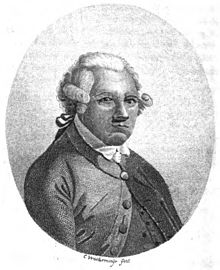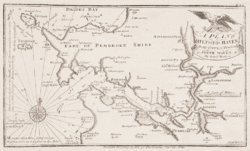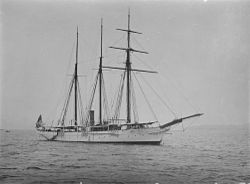Hydrography
This article needs additional citations for verification. (December 2020) |
Hydrography is the branch of applied sciences which deals with the measurement and description of the physical features of oceans, seas, coastal areas, lakes and rivers, as well as with the prediction of their change over time, for the primary purpose of safety of navigation and in support of all other marine activities, including economic development, security and defense, scientific research, and environmental protection.[1]
History

The origins of hydrography lay in the making of charts to aid navigation, by individual mariners as they navigated into new waters. These were usually the private property, even closely held secrets, of individuals who used them for commercial or military advantage. As transoceanic trade and exploration increased, hydrographic surveys started to be carried out as an exercise in their own right, and the commissioning of surveys was increasingly done by governments and special hydrographic offices. National organizations, particularly navies, realized that the collection, systematization and distribution of this knowledge gave it great organizational and military advantages. Thus were born dedicated national hydrographic organizations for the collection, organization, publication and distribution of hydrography incorporated into charts and sailing directions.
Prior to the establishment of the
Under Captain
The word hydrography comes from the Ancient Greek ὕδωρ (hydor), "water" and γράφω (graphō), "to write".
Overview

Large-scale hydrography is usually undertaken by national or international organizations which sponsor data collection through precise surveys and publish charts and descriptive material for navigational purposes. The science of oceanography is, in part, an outgrowth of classical hydrography. In many respects the data are interchangeable, but marine hydrographic data will be particularly directed toward marine navigation and safety of that navigation. Marine resource exploration and exploitation is a significant application of hydrography, principally focused on the search for hydrocarbons.
Hydrographical measurements include the
Hydrography, mostly for reasons of safety, adopted a number of conventions that have affected its portrayal of the data on nautical charts. For example, hydrographic charts are designed to portray what is safe for navigation, and therefore will usually tend to maintain least

Even though, in places, hydrographic survey data may be collected in sufficient detail to portray bottom topography in some areas,
A
Hydrography of
Hydrography of rivers and streams is also an integral part of water management. Most reservoirs in the United States use dedicated stream gauging and rating tables to determine inflows into the reservoir and outflows to irrigation districts, water municipalities and other users of captured water. River/stream hydrographers use handheld and bank mounted devices, to capture a sectional flow rate of moving water through a section and or current.
Equipment
Uncrewed Surface Vessels (USVs) and are commonly used for hydrographic surveys - they are often equipped with some sort of sonar. Single-beam echosounders, multibeam echosounders, and side scan sonars are all frequently used in hydrographic applications. The knowledge gained from these surveys aid in disaster planning, port and harbor maintenance, and various other coastal planning activities. [4][5]
Organizations
Hydrographic services in most countries are carried out by specialised hydrographic offices. The international coordination of hydrographic efforts lies with the International Hydrographic Organization.
The United Kingdom Hydrographic Office is one of the oldest, supplying a wide range of charts covering the globe to other countries, allied military organisations and the public.
In the United States, the hydrographic charting function has been carried out since 1807 by the
See also
- Bathymetric chart – Map depicting the submerged terrain of bodies of water
- Coastal geography – Study of the region between the ocean and the land
- Challenger expedition – Oceanographic research expedition (1872–1876)
- Hydrology – Science of the movement, distribution, and quality of water on Earth and other planets
- Hydrometry – Monitoring the components of the hydrological cycle
- World Hydrography Day – Publicate the importance of hydrographer
- Associations focussing on ocean hydrography
- International Federation of Hydrographic Societies (formerly The Hydrographic Society)
- State Hydrography Service of Georgia
- The Hydrographic Society of America
- Australasian Hydrographic Society
- Associations focussing on river stream and lake hydrography
- Australian Hydrographic Association
- New Zealand Hydrological Society
- American Institute of Hydrology
References
- ^ "International Hydrographic Organization". Archived from the original on 2014-07-24. Retrieved 2013-10-20.
- ^ "The United Kingdom Hydrographic Office timeline" (PDF). UKHO. Archived from the original (PDF) on 2011-07-21. Retrieved 2011-01-23.
- ^ "Charting the world for over 200 years". www.ukho.gov.uk. UKHO. Archived from the original on 2006-09-25. Retrieved 2006-11-15.
- ^ US Department of Commerce, National Oceanic and Atmospheric Administration. "Hydrographic Surveying". oceanservice.noaa.gov. Retrieved 2024-01-12.
- ^ "A Smooth Operator's Guide to Underwater Sonars and Acoustic Devices". Blue Robotics. Retrieved 2024-01-12.
- ^ "About Inland Survey".
- ^ "About Coast Survey".
External links
- Hydro International Lemmer, the Netherlands: Hydrographic Information ISSN 1385-4569]



